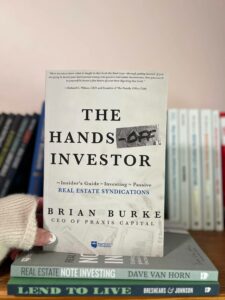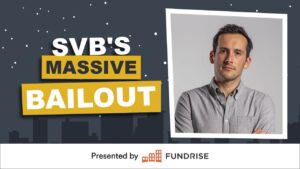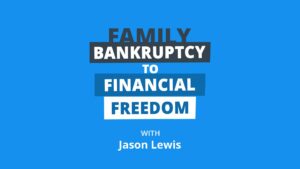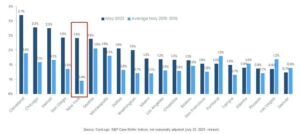
Americans have been waiting for a recession to kick in for the past year. With consumer sentiment down and debt piling up, it’s understandable why so many feel like the worst is yet to come. But what if the “hard landing” everyone was so afraid of already happened without us even noticing it? Could a “rolling recession” be why the economy never crashed at once? We’ve got Liz Ann Sonders, Charles Schwab’s Chief Investment Strategist, on the show to explain.
In a new report, Liz Ann touches on the one industry that could get hit hardest in 2024, what will happen if the labor market starts to break, and why we aren’t out of the woods yet for another recession. In today’s show, she’ll detail her findings and explain why SO many Americans feel now is an economically dangerous time, even while hard data points to confident consumers.
We’ll get Liz Ann’s take on the Fed rate cuts and whether or not they’ll even happen as the Fed eagerly awaits mortgage rate hike effects to finally kick in. Plus, recession indicators to watch in 2024 and why the bond markets could be pointing to something that no one else has been able to see.
Click here to listen on Apple Podcasts.
Listen to the Podcast Here
Read the Transcript Here
Dave:
Hey everyone. Welcome to On the Market. I’m your host, Dave Meyer, and we are going to be ending the year with an absolutely incredible and very special show. Today we have one of my personal heroes and role models coming on the show. Her name is Liz Ann Sonders. She is the chief investment strategist at Charles Schwab and is one of the best analysts and economists in the entire world. And I promise you, you all are going to learn a ton from our very interesting conversation. Liz Ann and her team at Charles Schwab recently released a report called US Outlook: One Thing Leads to Another, it just came out in the last couple of weeks and presents information and their basic outline for what they think is going to happen in the economy next year. And during our conversation today, we are going to talk about the report. We get in all sorts of topics like the concept of a recession or a soft landing and where Liz Ann thinks we fall on that spectrum.
We also talk about mortgage rates and bond yields, consumer spending and sentiment. And of course we are going to talk about the Fed and what they’ve been up to. But I think in addition to just Liz Ann’s opinions about these things, there’s a lot to learn in this episode because Liz Ann does a great job explaining what data you should pay attention to and why, and which data is just kind of noise that isn’t as important for investors like us when we’re making our decisions about our portfolio.
So, while you’re listening to this, in addition to what she says, also pay attention to the things she’s talking about, why she looks at certain indicators, why she ignores other indicators, because it can really help you sort through all the noise out there and just focus on the things that are going to help you build your portfolio in 2024. With that, let’s bring on Liz Ann Sonders, the Chief Investment Strategist at Charles Schwab.
Liz Ann Sonders, welcome back to On the Market. Thanks so much for being here.
Liz Ann:
Oh, thanks for having me. Happy holidays.
Dave:
Thank you, you too. For those of our audience who didn’t catch your first appearance on this show, can you please just briefly introduce yourself and what you do at Charles Schwab?
Liz Ann:
Sure. So Liz Ann Sonders. I am the Chief Investment Strategist at Schwab, a role I have had, I’ve been at Schwab since 2000, so long time. And before that I was at a firm called Zweig Avatar.
Dave:
During our last episode, we ended on something that I’d love to just pick up on, which was your concept of a rolling recession. Can you tell us a little bit about what a rolling recession is in your mind?
Liz Ann:
Sure. So there’s no precise definition. It’s just a term that we’ve chosen to use to describe what is obviously a very unique cycle. And I’m not going to go back three and a half years and run through the litany of things that makes it unique. But I think it is important to go back to the stimulus era during the early part of the pandemic because at the time that stimulus kicked in, both on the monetary side and the fiscal side, and it boosted the, economy dramatically very quickly and took the economy out of what was, although painful, a very short-lived pandemic recession. That stimulus and the demand associated with it was all funneled into the goods side of the economy, because services weren’t accessible. And that’s also where the inflation problem began on the goods side of various inflation metrics. But since then, we’ve not only seen hyperinflation go to disinflation to deflation in many categories on the goods side, we actually have had recessions in a rolling sense in manufacturing, housing, housing-related, a lot of consumer-oriented products and goods that were big beneficiaries of the stay-at-home phase.
And we’ve had more recent offsetting strength on the services side. That’s also where you saw the more recent pickup and inflation on the services side. Inherently those metrics are a little bit stickier. So when we think about the recession versus soft landing debate, I think that’s a little too simplistic because we’ve already had hard landings in some of those areas. To me, best-case scenario is a continued roll-through. Whereby if and when services needs to take a breather that you’ve got offsetting stability and/or maybe even recovery in areas that are already had their hard landing. So that’s in essence what we’re talking about.
Dave:
Just to make sure I understand and to explain to everyone, traditionally a recession, at least as it’s defined by the National Bureau of Economic Research, states that there needs to be significant declines in economic activity through a broad portion of the economy. And as Liz Ann is explaining here, what’s going on now is more like a whack-a-mole situation if you will, where one section of the economy might start to see a decline as Liz Ann said that was mostly in the goods area, and then services, a different sector of the economy might be strong and might in the future start to decline. So that’s why it’s rolling through the economy one industry at a time. And Liz Ann, you mentioned that some industries have had hard landings. Are there any that come to mind that have been particularly painful?
Liz Ann:
Well, housing, depending on what metric you’re looking at, you didn’t see epic-level declines in prices, at least not in existing homes. And I think that just has to do with the supply-demand imbalance, the fact that even though mortgage rates accelerated quite dramatically over the last year or so for the existing home market, so many homeowners are locked in at much lower mortgage rates and therefore they’re locked into their homes. But we did see pretty epic declines akin to the bursting of the housing bubble type declines in sales. Now we started to see a bit of recovery there, but that’s one area that saw compression. You certainly saw it in manufacturing broadly in certain components of manufacturing. And by the way, the weakness in manufacturing without the attendant weakness, we’ve had a little bit of weakness in services, but nowhere near the extreme helps to explain why an index like the LEI, the Leading Economic Index, which has 10 subcomponents has been flashing recession.
Now that index is more manufacturing-biased, not because the conference board that created the index is missing something. They know that services is a larger portion of the US economy, but manufacturing does tend to lead, and that’s why there’s more of a manufacturing bias in the leading indicators. But that helps to explain a disconnect too, given that we’ve seen recession in manufacturing, it’s picked up in something like the LEI, but it hasn’t manifested itself in this big decline in the economy because of the resilience in services, which is a larger, by the way, services is also a larger employer, helping to explain why the labor market has been so resilient.
Dave:
I’d love to talk a little bit more in a minute about the services and what might happen in 2024, but I’m just curious your opinion on the implications of this rolling recession, because in my mind, parts of it seemed to be positive, right? Rather than having this one deep recession, different sectors of the economy are performing at different levels, but it also feels like it’s sort of dragged out the economic pain and people are still sort of waiting for some definitive event to happen to declare a recession or to declare that the economy’s better and it feels like we’re sort of in this economic purgatory right now. Do you think this is having a psychological effect on businesses and American consumers?
Liz Ann:
I do. In fact, I think that that’s an important question because it brings up another unique facet to this cycle, and that is that the psychological ways we measure growth in the economy, whether it’s things like consumer confidence or consumer sentiment, they’re very similar monthly readings, they’re put out by two different organizations. Consumer confidence tends to be a little bit more biased to what’s going on in the labor market where consumer sentiment tends to be a little bit more biased to what’s going on with inflation. So you can see divergences there. You can also look at other surveys like CEO Confidence, well, that’s considered soft economic data, survey-based data. What are people saying? What’s their mood? What’s been interesting is the hard data does not corroborate the much weaker soft data. In other words, you’ve had this very dour backdrop of consumer confidence/sentiment, but you haven’t seen the equivalent in consumer spending.
You’ve seen this very dour recessionary-like backdrop in CEO confidence, but as a proxy maybe for what would make them confident or not would be corporate earnings. And although corporate earnings were slightly negative in the last year or so, nowhere near to the degree that you would expect given the weakness in CEO confidence. So that’s another unique aspect to this cycle is a pretty wide gap between the sort of attitudinal or soft economic data and the actual hard activity-based data. So that’s good news in the sense that yes, we’re seeing it psychologically, but it’s not manifesting itself in behavior that’s commensurate with the weakness in confidence.
Dave:
That makes a lot of sense, and I just experience that almost every day. When you talk to someone about the economy, almost always you hear negativity or pessimism or fear, but when you look at these macro indicators, you see pretty strong reports coming out of multiple different sectors of the economy. So it does just feel like there’s this sort of strange disconnect and that’s why I really appreciate your analysis and terming of the rolling recession because it does explain, at least in my mind, a lot of what’s driving that psychological element.
Liz Ann:
And by the way, I agree it is arguably a better backdrop than a recession where the bottom falls out all at once, particularly in an extreme way like was the case in 2008. I mean that was a protracted recession, but certainly that acute ’08 part was the bottom falls out all at once, and I think probably anybody would choose more of a roll through than that. But you’re right, it does leave I think a lot of people in this state of limbo and uncertainty for maybe a more extended period of time.
Dave:
You mentioned that the best case scenario in your mind heading forward is a continued roll through. So presumably some sectors recover, others go into an economic decline, and you mentioned services as being potentially one of the areas that might get hit. Why do you think services are one of the big things to watch in 2024?
Liz Ann:
Particularly in areas where the strength has been a bit more recent, where the job growth has been more recent, reflecting the revenge spending on things like travel and leisure and hospitality. I think that the key ingredient to keeping that afloat, and we have started to see some cracks, ISM services index, which is a proxy for the broader services category, that has weakened from recent peaks. You’re seeing it in a smattering of ways where we may be not at the exhaustion point, but at some point you’ve met that pent-up demand. But I think the real key is the labor market. I think if the labor market can remain resilient, I think that’s been a thing that consumers are hanging onto to maintain that consumption, which again, in more recent periods has been more sort of services-oriented or experiences-oriented as opposed to things, stuff, goods.
I think if we start to see more cracks in the labor market, given that metrics like the savings rate, the diminution of the so-called excess savings, the fact that delinquencies for auto loans, for credit card loans are really picking up particularly down the income spectrum into the subprime categories, the increased use of credit cards for those that are turned off by the high fees or high interest rates, the increased use of buy now pay later, those are signs that there’s at least some pocket of the consumer that is starting to get a little bit tapped out. But I think there’s been this reliance on the health of the labor market as a buffer, and I think if we were to start to see more than just the cracks we have seen, I think that that would have a feeder on the services consumption side that might occur a bit more quickly.
Dave:
So in your outlook for 2024, are you forecasting breaking the labor market or at least an uptick in the unemployment rate?
Liz Ann:
So we had gotten obviously an uptick in the unemployment rate from 3.4 at the low to 4%, and then that came back down to 3.7%. What’s interesting about the unemployment rate is you don’t historically see a lot of jump around volatility. It tends to be trending in one direction and then there’s the inflection and then it tends to trend in the other direction. It’s not like a metric initial unemployment claims where you can see an incredible amount of volatility. So it was a bit of a surprise. I think in general, the unemployment rate is probably going to be trending higher. That’s just the nature of being later in an economic cycle. But there is also truth to this notion of labor hoarding and the fact that for a lot of companies, the skills gap, the labor shortages were so acute that I think they’re more hesitant to use that, laying off people as a cost-cutting mechanism.
So there is that sort of hanging on of labor. You’ve seen it picked up in other metrics like hours worked having come down. You’re also seeing cracks under the surface. For instance, with initial unemployment claims, which continue to be very low, that’s a weekly reading, but there’s attendant report or a metric that comes out every Thursday morning with initial claims, which is continuing claims measures, not people who have just initially filed for unemployment insurance in the prior week, but people who continue to be on unemployment insurance. And the fact that that has accelerated to a much more significant degree than initial unemployment claims tells you that it’s taking a bit longer for people to find jobs. So it really just is peeling a layer or two of the onion back to see where we’re starting to see some cracks. I don’t anticipate some major move up in the unemployment rate.
I think that there is resilience in the labor market. There is truth to that notion of labor hoarding, but it’s what happens when you’re later in the cycle. And by the way, one mistake that a lot of economic watchers or market watchers, investors, whatever term you want to use make is they think of the unemployment rate almost as a leading indicator and it manifests itself in questions I get all the time. Why is anyone talking about a recession when the unemployment rate is so low? Wouldn’t that, I’m paraphrasing different forms of the question, wouldn’t that have to go up a lot to bring on a recession? Well, it’s actually the opposite that happens. Recessions happen for lots of reasons, and eventually the recession causes the unemployment rate to go up. It’s not the other way around. So that’s why it’s important to look at things like unemployment claims and even more leading than that, layoff announcements and job openings because those are where you pick up in a leading way signs that eventually will work their way into a rising unemployment rate.
Dave:
That’s an excellent analysis and detailed opinion about the labor market and underscore something we talk about on the show that I want to remind everyone that there are lots of ways to look at the labor market. No one is perfect and as Liz and clearly stated, you sort of have to look at the whole picture by understanding the unemployment rate, how many people are filing for claims, how many hours are work, the labor participation rate. There’s a lot to understand. So if you want to use this type of data and information in your own investing, you should, but make sure to get a holistic picture and not just cherry-pick one sort of metric and use that as your barometer for the labor market. Liz Ann, you mentioned that we’re late in this cycle and your report discusses this at length and talks about how rate hikes have a quote long and variable lag associated with them. Can you explain this concept to our audience?
Liz Ann:
The terminology of long and variable lags dates back to the late great Milton Friedman who wrote about that in one of his books. And it’s really just this idea that changes in monetary policy. In other words, the Fed raising interest rates or lowering interest rates, the impact that that has on the economy from a time perspective is very variable. We know the lags are long, meaning the Fed raises rates, it doesn’t have an immediate and in the moment impact on the economy. It takes a little while, but the time it takes and the magnitude of that impact is very variable over time. And that’s really what we just wanted to point out. It’s also justification, and the Fed has stated as such for the Fed being what we believe to be in pause mode right now, we do think that the July 2023 rate hike was the final one in the cycle because they feel that they’ve done enough tightening.
It was the most aggressive tightening cycle in more than 40 years. And this is the time now to assess the impact given those long and variable lags. And the other point we made in the report looking at things like the decline in the leading indicators, which we touched on, the inversion of the yield curve, any number of measurements that in the past have been pretty good recession indicators that were still within the range of time spans historically that have incorporated when you finally see the impact. So that was why one of our conclusions was we’re not really past the expiration date, maybe not a recession per se, but we’re not past the expiration date of continuing to worry about this. There’s not some point where we can say every metric that has been calling for a recession, we’re way past the historical range of impact, therefore nothing to see here, nothing to worry about. Let’s celebrate. So we’re still within the variable range associated with the past, even including the unique characteristics of this cycle.
Dave:
That’s super important and your report does a great job pointing out that all of these indicators that market watchers point to that there should be a recession or is likely to be a recession. Even historically there is a long lag. Some of them take 24 months or 18 months, meaning that even though the Fed is in pause mode, the economy is very possibly still feeling the impact of rate hikes that happened, not just the most recent one, but ones that happened 12 months ago or perhaps even 18 months ago.
I’m curious if the recent Fed news, and as a reminder we are recording this towards the end of December, we just heard from the Fed that they’re continuing to pause and the most recent dot plot, which is a projection of where the Fed thinks that their federal funds rate will be in coming years, shows a potential for three rate cuts next year. Do you think that Fed’s signaling that they might bring down rates might blunt sort of this lag effect? There’s always this lag effect and part of me always thinks about how that’s psychological, that if rates stay high, people are a little less willing to invest money, they’re a little more timid, and now, perhaps the Fed is trying to blunt the impact of some of their more recent rate hikes and get people to start spending and feeling a bit more confident again.
Liz Ann:
That may be indirectly a part of it. To be perfectly honest, we were a little surprised at the telegraphing of a pivot. It’s been generally deemed to have been a more dovish meeting, particularly once the press conference started and Jerome Powell was taking questions. Now, that said, there is still a pretty wide gap between, to your point, what the dots plot, what is suggested by the expectations of Fed members for three rate cuts in 2024 versus now. The market’s expectation of six rate cuts in 2024. I think at this point, all else equal, given what we know now, and the rub is that the Fed is data-dependent, so the data will define when they start to cut and how aggressively, but given what we know now, to me it looks like the Fed is probably more right than the market. But in terms of blunting the impact, yeah, I mean the Fed looked at what in November was the most amount of financial conditions easing in a single month in the history of these multiple indexes that measure financial conditions.
And that was one of the reasons why there was an assumption that Powell at the meeting would a bit more hawkish and say, “Look, the loosening of financial conditions has done some of the job for us. We can stay in pause mode maybe longer.” But he did kind of do that more dovish kind of pivot to an expectation of rate cuts. But there is still a fairly yawning gap between what the Fed is telegraphing and via its dots. It’s not telegraphing anything, it’s data dependent. So they’re not on some predetermined path, but I think six seems fairly aggressive given that inflation is not anywhere near the fed’s target, and they claim that that’s what they want to see. So I wouldn’t be surprised if as we get into the beginning of 2024 if we don’t see continued significant disinflation and/or if the economy continues to behave quite well and we don’t see any further cracks in the labor market or maybe even strengthening in the labor market. It wouldn’t surprise me for the Fed to have to push back again against rate cuts starting as soon as three months into the next year.
Dave:
For what it’s worth, I was also very surprised. It’s not like we saw these amazing inflation numbers and as you said, financial conditions were already loosening. So it is a bit of surprise and I just want to remind everyone who’s mostly real estate investors here that although for those of us who are looking forward to lower mortgage rates, this may be encouraging, but certainly not guaranteed. We’ve seen mortgage rates move down about 100 basis points in the last couple of weeks, but as Liz Ann just pointed out, we don’t know what the Fed is going to do. They’re going to wait and see more economic data. And we also don’t know how the bond market and mortgage-backed security markets are going to react to further economic data.
Liz Ann:
And that’s a key point because it’s the 10-year yield that’s most directly correlated to mortgage rates, not the Fed Funds rate, which is what the Fed has direct control over. So that’s why it’s the market forces associated with the bond market and longer term yields that will influence mortgage rates.
Dave:
Well, that brings me to my final subject here that I want to talk about, which is the yield curve. Because bond yields are so pivotal in setting mortgage rates, as a real estate investor, I am very curious for your take on the yield curve, but for those who aren’t familiar, can you just explain what the yield curve is?
Liz Ann:
There’s different yield spreads that are measured to then declare an inversion, which would in general just be when short-term interest rates are higher than long-term interest rates. It’s probably the two most popular yield spreads that are analyzed when looking for an inversion, how deep the inversion is would be the 10-year versus the three-month treasury or the 10-year versus the two-year. And it reflects an environment where early and even in advance of a tightening cycle, you’ve got still elevated short-term interest rates, but the bond market is starting to anticipate weaker economic growth and an eventual easing cycle by the Fed. So those longer term yields will come down and once they go below the shorter term yields, that’s when the yield curve inverts, which occurred now more than a year ago. And it was a very deep inversion. What’s interesting is recently when the yield curve started to steepen again, I heard a lot of comments saying, “Well, an inversion of the yield curve has been a pretty perfect historical precursor to a recession, and now that it’s un-inverting, which that was fairly short-lived, we don’t have to worry about recession anymore.”
But what’s interesting is that if you look at the long history of this, the inversion, if you want to use a weather analogy, inversions are the warning, and steepenings are actually the watch, because recessions have actually typically started after a steepening. And in many cases where the yield curve is actually un-inverted, and that’s because the long end starts to come down in anticipation of Fed easing to come. And so that’s another, I think misperception much like the relationship between the unemployment rate and recessions, inversions and recessions, it’s actually the steepening that is the watch, it’s the inversion that’s the warning. But it also reflects problems in the financial system given that most financial institutions, they borrow on the short end and they lend out at the long end and they make that spread. And that’s what then provides juice to the economy. It gives them the ability to lend and keep the credit markets open, and an inversion really stunts that. And so it works its way through the financial system and through lending standards. And that’s ultimately how it impacts the economy.
Dave:
Given the importance of the steepening, what is happening with the yield curve of late? You mentioned that it inverted I think over a year ago, but has there been any recent movement of note?
Liz Ann:
Well, yeah. So the 10-year as a perfect example, went from a 5% where it hit for a fairly short period of time all the way down to when I looked before coming on here, it was sub-3.9. So that’s an extraordinary swing in the 10-year yield. And by the way, has had direct implications for the equity market, which was one of the themes in our report that really the bond market has been in the driver’s seat of the equity market. And the period from mid-July or so until the end of October when the 10-year yield was surging on the upside, ultimately hitting that 5% peak, that was the period when the US equity market had its correction. S&P down 10%, NASDAQ down 12 or 13%.
And then since then, the peak in the 10-year yield at 5% all the way back down to below 4% has been very much what’s behind the incredible move off the lows at the end of October for the equity market. So there has been a very, very direct relationship between what’s going on in the bond market with an inverse relationship between yields and stock prices, higher yields met lower stock prices and vice versa more recently.
Dave:
Thank you for explaining that. That’s super helpful for all of us who are so interested and watch the bond markets pretty carefully. Liz Ann, before we get out of here, I’d just love to hear from you what you would recommend to our audience, if there’s a couple of indicators that you think they should be watching heading into 2024 to understand the health of the US economy.
Liz Ann:
Well, one thing that’s always important to understand is which economic indicators, and we’re barraged with them on a daily, weekly, monthly basis, but what bucket they fall into, are they a leading indicator? Are they a coincident indicator? Are they a lagging indicator? And that applies to not just labor market data. I mentioned initial unemployment claims, a key leading indicator, payrolls, a coincident indicator. The unemployment rate, not only a lagging indicator, one of the most lagging of indicators. So that’s really important is understanding which fall in which buckets. Understanding that at times there can be a big difference between the soft and the hard economic data, which we touched on. So survey-based data versus actual hard activity-based data, kind of like you’ve got to look at what they’re doing, not just what they’re saying, whether it’s consumers or CEOs. But I think at this point, I happen to believe that what the Fed will key off of when it comes time to start to cut rates, actually pivoting to rate cuts, not just staying in pause mode, will be the combination of their dual mandate, inflation and the labor market.
So on the tightening part of the cycle, they were almost solely focused on their inflation mandate. That was what was triggering the rate hikes in this very aggressive cycle. I don’t think, they don’t not care about inflation anymore, but I think the labor market, the employment half of their dual mandate, I think will sit alongside the inflation data and it’s the combination of the two that will send the message to the Fed. Okay, you can feel somewhat confident that not only has inflation come down to or close to the target, but conditions in the labor market are not such that it’s likely to reignite inflation again if we start to ease policy. So we always pay attention to labor market data, but the point is that I think the Fed is going to have a more keen eye on that than was the case during the tightening part of the cycle.
Dave:
All right, well thank you so much, Liz Ann. We’ll of course link to your report in the show notes. Is there anywhere else people can find you if they want to follow your work?
Liz Ann:
Sure. So all of our work is actually on the public site of Schwab.com. That’s one thing a lot of people don’t realize. You don’t have to be a client, you don’t need to log in. There’s a learn section on Schwab.com. That’s where all of our written, what we heard is. That said, probably the most efficient way to get everything, not just written reports and videos and links to our new podcast, but the daily massive production of charts and reactions to economic data on either Twitter, X, formerly known as Twitter, or LinkedIn. So that’s probably the easiest sort of one-stop shopping way to get everything.
Dave:
Absolutely. And we’ll make sure to link to Liz Ann’s Twitter or X profile as well as her LinkedIn profile below, if you want to check that out. Liz Ann, thanks again for joining us. We really appreciate it. Have a happy New Year.
Liz Ann:
You too. Thank you.
Dave:
On the Market was created by me, Dave Meyer and Kaitlin Bennett. The show is produced by Kaitlin Bennett, with editing by Exodus Media. Copywriting is by Calico Content, and we want to extend a big thank you to everyone at BiggerPockets for making this show possible.
Watch the Episode Here
Help Us Out!
Help us reach new listeners on iTunes by leaving us a rating and review! It takes just 30 seconds and instructions can be found here. Thanks! We really appreciate it!
In This Episode We Cover:
- The “rolling recession” and why a “hard landing” may have already hit
- One industry that could get hit HARD in 2024 if the labor market starts to weaken
- Why we haven’t felt the full effect of the Fed’s rate hikes yet
- Fed rate cut predictions and how long the Fed could continue to hold high rates
- Recession indicators and what the bond market tells you that no one else is talking about
- And So Much More!
Links from the Show
Connect with Liz:
Interested in learning more about today’s sponsors or becoming a BiggerPockets partner yourself? Email [email protected].
Note By BiggerPockets: These are opinions written by the author and do not necessarily represent the opinions of BiggerPockets.
- SEO Powered Content & PR Distribution. Get Amplified Today.
- PlatoData.Network Vertical Generative Ai. Empower Yourself. Access Here.
- PlatoAiStream. Web3 Intelligence. Knowledge Amplified. Access Here.
- PlatoESG. Carbon, CleanTech, Energy, Environment, Solar, Waste Management. Access Here.
- PlatoHealth. Biotech and Clinical Trials Intelligence. Access Here.
- Source: https://www.biggerpockets.com/blog/on-the-market-172
- :has
- :is
- :not
- :where
- ][p
- $UP
- 1
- 10
- 100
- 12
- 12 months
- 2000
- 2008
- 2023
- 2024
- 24
- 30
- 40
- 9
- a
- ability
- Able
- About
- absolutely
- accelerated
- accessible
- activity
- actual
- actually
- acute
- addition
- advance
- afraid
- After
- again
- against
- aggressive
- aggressively
- ago
- akin
- All
- almost
- alongside
- already
- also
- Although
- always
- am
- amazing
- American
- Americans
- amount
- an
- analysis
- Analysts
- analyzed
- and
- Announcements
- Another
- anticipate
- anticipation
- any
- anymore
- anyone
- anything
- anywhere
- Apple
- applies
- appreciate
- ARE
- AREA
- areas
- arguably
- around
- AS
- aspect
- assess
- associated
- assumption
- At
- attention
- audience
- author
- auto
- avatar
- back
- backdrop
- basic
- basis
- BE
- because
- becoming
- been
- before
- began
- Beginning
- behavior
- behind
- being
- believe
- below
- beneficiaries
- BEST
- Better
- between
- bias
- biased
- Big
- Bit
- board
- bond
- bond market
- Bond Markets
- Bond yields
- Books
- Boosted
- border
- borrow
- both
- Bottom
- Break
- Breaking
- briefly
- bring
- Brings
- broad
- broader
- broadly
- bubble
- buffer
- build
- Bureau
- businesses
- but
- buy
- buy now pay later
- by
- called
- calling
- came
- CAN
- card
- Cards
- care
- carefully
- case
- cases
- Catch
- categories
- Category
- causes
- celebrate
- ceo
- CEOs
- certain
- certainly
- Changes
- characteristics
- Charles
- charles schwab
- Charts
- check
- chief
- Choose
- chosen
- claim
- claims
- clearly
- client
- Close
- COM
- combination
- come
- comes
- coming
- comments
- Companies
- components
- concept
- conditions
- Conference
- conference board
- confidence
- confident
- considered
- consumer
- consumer sentiment
- Consumers
- consumption
- content
- continue
- continued
- continues
- continuing
- control
- Conversation
- copywriting
- Corporate
- correlated
- corroborate
- could
- Couple
- course
- cover
- Crashed
- created
- credit
- credit card
- Credit Cards
- curious
- curve
- Cut
- cuts
- cycle
- daily
- Dangerous
- data
- data points
- Date
- Dates
- Dave
- day
- debate
- December
- decisions
- Decline
- Declines
- deemed
- deep
- define
- defined
- definition
- definitive
- deflation
- Degree
- Demand
- dependent
- Depending
- describe
- detail
- detailed
- DID
- difference
- different
- different forms
- direct
- direction
- directly
- Display
- do
- does
- Doesn’t
- doing
- done
- Dont
- DOT
- Dovish
- down
- dramatically
- driving
- during
- eagerly
- Early
- Earnings
- ease
- easiest
- easing
- Economic
- Economic growth
- economic indicators
- economists
- economy
- economy’s
- editing
- effect
- effects
- efficient
- either
- element
- elevated
- else
- employment
- encouraging
- end
- ended
- ending
- enough
- Entire
- Environment
- EPIC
- episode
- equal
- equity
- Equivalent
- Era
- essence
- estate
- Ether (ETH)
- Even
- Event
- eventual
- eventually
- Every
- every day
- everyone
- everything
- example
- excellent
- excess
- existing
- Exodus
- expect
- expectation
- expectations
- experience
- expiration
- Explain
- explaining
- extend
- extended
- extraordinary
- extreme
- eye
- fact
- fairly
- Fall
- Falls
- familiar
- fear
- Fed
- fed funds rate
- Federal
- Federal Funds Rate
- feel
- feeling
- feels
- Fees
- felt
- filed
- Filing
- final
- Finally
- financial
- Financial institutions
- financial system
- Find
- findings
- Firm
- First
- Fiscal
- flashing
- Focus
- focused
- follow
- For
- For Investors
- Forces
- formerly
- forms
- Forward
- found
- from
- full
- funds
- further
- future
- gap
- General
- generally
- get
- given
- gives
- Go
- going
- good
- goods
- got
- great
- Growth
- guaranteed
- had
- Half
- happen
- happened
- Happening
- happens
- happy
- Hard
- Have
- having
- Hawkish
- he
- Heading
- Health
- hear
- heard
- help
- helpful
- helping
- helps
- her
- here
- Heroes
- Hesitant
- Hidden
- High
- higher
- Hike
- Hikes
- his
- historical
- historically
- history
- Hit
- hitting
- hoarding
- hold
- holidays
- holistic
- Home
- Homes
- honest
- hospitality
- host
- HOURS
- housing
- How
- HTTPS
- hyperinflation
- i
- idea
- if
- imbalance
- immediate
- Impact
- Impacts
- implications
- importance
- important
- in
- In other
- Including
- Income
- Incorporated
- increased
- incredible
- index
- indexes
- Indicator
- Indicators
- indirectly
- industries
- industry
- inflation
- Inflection
- influence
- information
- ingredient
- inherently
- initial
- initially
- instance
- institutions
- instructions
- insurance
- interest
- Interest Rates
- interested
- interesting
- into
- introduce
- inversion
- Invest
- investing
- investment
- investor
- Investors
- IT
- ITS
- itself
- iTunes
- jerome
- jerome powell
- Job
- Jobs
- joining
- joining us
- jpg
- July
- jump
- just
- Keen
- Keep
- keeping
- Key
- kick
- Kind
- Know
- known
- labor
- labor market
- lagging
- landing
- larger
- Last
- Last Year
- Late
- later
- layer
- laying
- LAYOFF
- lead
- leading
- Leads
- LEARN
- learning
- least
- Leave
- leaving
- Leisure and Hospitality
- LEND
- lending
- Length
- less
- levels
- LG
- like
- likely
- LINK
- LinkedIn profile
- links
- Listening
- little
- Loans
- locked
- log
- Long
- long time
- long-term
- longer
- Look
- looked
- looking
- LOOKS
- Lot
- lots
- love
- Low
- lower
- lowering
- Lows
- Macro
- made
- maintain
- major
- make
- MAKES
- Making
- mandate
- manufacturing
- many
- many people
- Market
- Market Data
- market forces
- Markets
- massive
- May..
- maybe
- me
- mean
- meaning
- measure
- measured
- measurements
- measures
- mechanism
- Media
- meeting
- Members
- mentioned
- message
- met
- metric
- Metrics
- Meyer
- might
- Milton
- mind
- minute
- missing
- mistake
- Mode
- models
- moment
- Monetary
- Monetary Policy
- money
- Month
- monthly
- months
- mood
- more
- morning
- Mortgage
- most
- Most Popular
- mostly
- move
- movement
- much
- multiple
- my
- name
- Nasdaq
- National
- National Bureau of Economic Research
- Nature
- Near
- necessarily
- Need
- needs
- negative
- never
- New
- new target
- new year
- news
- next
- no
- Noise
- None
- note
- Notes
- nothing
- Notion
- November
- now
- number
- numbers
- occur
- occurred
- october
- of
- off
- offsetting
- Okay
- on
- once
- ONE
- ones
- only
- open
- openings
- Opinion
- Opinions
- opposed
- opposite
- or
- organizations
- Other
- Others
- our
- out
- outline
- Outlook
- over
- own
- Pain
- painful
- pandemic
- part
- participation
- particularly
- partner
- parts
- past
- path
- pause
- Pay
- Payrolls
- Peak
- People
- per
- perfect
- perfectly
- performing
- perhaps
- period
- periods
- personal
- perspective
- pessimism
- phase
- pick
- picked
- picking
- Pickup
- picture
- Pivot
- pivotal
- plato
- Plato Data Intelligence
- PlatoData
- player
- please
- plus
- podcast
- Podcasts
- Point
- points
- policy
- Popular
- portfolio
- portion
- positive
- possible
- possibly
- potential
- potentially
- Powell
- precise
- precursor
- presents
- press
- pretty
- Prices
- Prior
- probably
- Problem
- problems
- Produced
- Production
- Products
- Profile
- Projection
- promise
- protected
- provides
- proxy
- psychological
- public
- Push
- push back
- put
- question
- Questions
- quickly
- quite
- quote
- raises
- raising
- range
- Rate
- Rate Hike
- rate hikes
- Rates
- rather
- rating
- reach
- React
- reactions
- Reading
- real
- real estate
- realize
- really
- reasons
- recent
- recently
- recession
- recommend
- recording
- Recover
- recovery
- reflecting
- reflects
- relationship
- relative
- released
- reliance
- remain
- reminder
- report
- Reports
- represent
- research
- resilience
- resilient
- right
- rising
- Role
- Roll
- Rolling
- round
- Run
- S&P
- Said
- sales
- Savings
- saw
- say
- saying
- says
- scenario
- seconds
- Section
- sector
- Sectors
- security
- see
- seeing
- seemed
- seems
- seen
- send
- sense
- sentiment
- Services
- setting
- she
- Shopping
- Short
- short-term
- shortages
- should
- show
- Shows
- side
- significant
- Signs
- similar
- simplistic
- since
- single
- sit
- site
- situation
- SIX
- skills
- skills gap
- So
- Soft
- solely
- some
- Someone
- something
- somewhat
- Soon
- spans
- special
- Spectrum
- Spending
- Sponsors
- spread
- Spreads
- Stability
- standards
- start
- started
- Starting
- starts
- State
- stated
- States
- stay
- staying
- Still
- stimulus
- stock
- strange
- Strategist
- strength
- strengthening
- strong
- subject
- such
- Super
- sure
- Surface
- surging
- surprise
- surprised
- Swing
- system
- Take
- takes
- taking
- Talk
- talking
- Talks
- Tapped
- Target
- team
- tell
- tells
- tend
- tends
- term
- terminology
- terms
- than
- thank
- thanks
- that
- The
- the Fed
- The Future
- their
- Them
- themes
- then
- There.
- therefore
- These
- they
- thing
- things
- think
- Thinks
- this
- those
- though?
- three
- Through
- thursday
- tightening
- time
- times
- to
- today
- today’s
- Ton
- too
- took
- Topics
- touched
- touches
- towards
- traditionally
- Transcript
- travel
- treasury
- Trend
- trending
- triggering
- truth
- trying
- Turned
- two
- type
- typically
- Ultimately
- Uncertainty
- under
- underscore
- understand
- understandable
- understanding
- unemployment
- Unemployment Insurance
- unemployment rate
- unique
- until
- Upside
- us
- US economy
- use
- variable
- various
- Versus
- very
- via
- vice
- Video
- Videos
- Volatility
- wait
- Waiting
- want
- wanted
- warning
- was
- Watch
- watching
- Way..
- ways
- we
- weaker
- weakness
- Weather
- week
- weekly
- Weeks
- welcome
- WELL
- went
- were
- whack-a-mole
- What
- What is
- whatever
- when
- whether
- which
- while
- WHO
- whole
- why
- wide
- will
- willing
- with
- within
- without
- Woods
- words
- Work
- worked
- works
- world
- worry
- Worst
- worth
- would
- written
- wrote
- X
- year
- years
- yes
- yet
- Yield
- yield curve
- yields
- you
- Your
- yourself
- youtube
- zephyrnet












